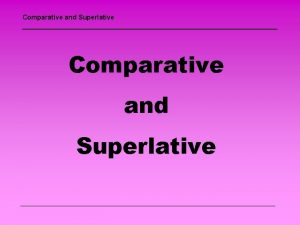The peculiar NPQ regulation in the pinguiophyte Phaeomonas

- Slides: 1

The peculiar NPQ regulation in the pinguiophyte Phaeomonas sp. challenges the xanthophyll cycle dogma Nicolas 1 Génétique 1 Berne , Bastienne 1 Istaz , Tereza 1 Fábryová , Benjamin 1, 2 Bailleul & Pierre 1 Cardol. et Physiologie des Microalgues, Département des Sciences de la vie and Phyto. SYSTEMS, Université de Liège, B-4000 Liège, Belgium 2 Present adress: Laboratoire de physiologie membranaire et moléculaire du chloroplaste (UMR 7141), IBPC, UPMC/CNRS, F-75005 Paris, France A peculiar NPQ regulation in Phaeomonas sp. When photosynthetic organisms experience fluctuating light condition, they can develop different strategies to finely balance light harvesting, photochemistry, and protection from excess photons. One of those strategies is the high energy state quenching (q. E), a component of the NPQ (Non Photochemical Quenching), consisting in the dissipation of excess light energy in the form of heat within photosystem II. This mechanism is tightly related to the xanthophyll cycle (XC), which consists in the reversible de-epoxidation of some carotenoids. In viridiplantae, the (ascorbate, Δp. H) regulation of the XC is made (NADPH, through the activation of the O 2) from Niyogi et al, PNAS, 1997 violaxanthin de-epoxidase (VDE) by the light-driven Δp. H. Surprisingly, the pinguiophyte Phaeomonas sp, displays a huge NPQ in the Fig 1. Generation of a xanthophyll Fig 2. Relaxation of the Fig 3. Light dependency of dark (Fig. 1), which is dependent on the XC: it is suppressed by the VDE cycle dependent NPQ after a light. NPQ and XC pigments in NPQ and XC inhibitor dithiothreitol (DTT). to-dark transition Phaeomonas sp. after a dark-to-moderate This NPQ recovers under low light (Fig. 2), following the activity of the light transition zeaxanthin epoxidase (ZE). ZE activity and NPQ recovery depend on the photosynthetic electron transfer from PSII to NADP+ : they are suppressed in Because of the peculiar dark behavior, the conventional nomenclature for the presence of DCMU or DBMIB. calculation of NPQ is not adapted. Instead we calculated NPQ as (Fmll Fm’)/Fm’, where Fm’ is the maximal fluorescence in a given light condition, NPQ and violaxanthin de-epoxidation also occur under high light (Fig. 3). The and Fmll the one under a “reference” low light (30 μmol quanta. m-2. s-1). peculiar light dependencies of NPQ and XC in this species , shown in Fig. 3, offers a unique opportunity to study the xanthophyll cycle, and to dissect its different regulators. Due to the presence of a pmf in the dark, the VDE is already active in the absence of photosynthesis ZE shows a strong light dependency, mirroring NPQ In Phaeomonas sp. , like in diatoms (Lavaud et al, Plant Physiol, 2002), the NPQ is proportional to the de-epoxidized xanthophyll (here zeaxanthin, Fig. 4). This provides a fast and non-invasive measurement of the ZE activity. When the VDE is inhibited (with DTT) in a sample quenched beforehand, only the ZE is active and the recovery of the NPQ is a direct measurement of the epoxdation activity. The ZE activity is null in the dark and low under high light, but shows an optimum under low light conditions (Fig. 5 a). Two electrochromic (ECS) probes are present in Phaeomonas sp. (Fig. 6 a), displaying linear and quadratic dependencies upon the transthylakoidal electric field (ΔΨ). Like in diatoms (Bailleul et al, Nature, in press), the absolute value of the ΔΨ can be measured thanks to those two probes. A ΔΨ is present in the dark, which is suppressed by the ionophore FCCP (Fig. 6 b, red arrow). Fig 4. Zeaxanthin content as a function of NPQ. Data from Fig. 1 (open circles), Fig. 2 (close circles) and Fig. 3 (stars). In addition, the inhibition of the NPQ generation in the dark, when nigericin (H+/K+ antiporter) is added, indicates that the activity of the VDE is dependent on the presence of a Δp. H in the dark (Fig. 7). The light dependency of the zeaxanthin epoxidation rate mirrors the one of the NPQ (Fig 3 and Fig 5 b), strongly suggesting that the regulation of the ZE plays an important role in the overall XC regulation in Phaeomonas sp. a) b) Fig 4. Fig 5. Light dependency of the epoxidation rate, calculated from the NPQ recovery rate in DTT treated cells. a) Typical kinetics of NPQ recovery at 0, 128 and 450 μmol quanta. m-2. s-1. b) Calculation of the epoxidation rate from the mono-exponential fit of the NPQ recovery. From 4 independent biological samples (±S. D. ). All rates were normalized to the value at 60 μmol quanta. m-2. s-1 Conclusions. Fig 6. Linear and quadratic electrochromic probes allow the measurement of the dark ΔΨ. Top: Spectra of the linear (blue) and quadratic (red) ECS components. Bottom: Quadratic vs linear ECS during the decay of a light-induced pmf, in control and FCCP conditions (arrow = dark ΔΨ) Phaeomonas sp. displays an unusual light dependency of the NPQ, the latter being maximal in the dark. This is due to: • the light dependency of the zeaxanthin epoxidase, most likely via the availability of its substrate NADPH. • the presence of a proton motive force (ΔΨ and Δp. H) in the dark, which pre-activates the VDE Thus, both osmotic and electric components of the pmf are present in the dark. The presence of this dark pmf allows a sufficient acidification of the lumen to activate the VDE in the absence of photosynthetic activity. Fig 7. Nigericin inhibition of the NPQ generated after a light-to -dark transition. Pending Questions and Future Work Is the ZE, and in turn NPQ, regulated by the amount of NADPH in the stroma? Why this “dark NPQ” ? Does it provide photoprotection to photosystem II ? Are those features specific to Phaeomonas sp. ? Probe the NADPH/NADP+ reduction state in the light in vivo, and correlate with the activity of the ZE Probe the PSII photo-inhibition rate at the onset of light (control vs DTT). Testing other stramenopiles, like diatoms. Acknowledgement: This work has been supported by the Belgian Fonds de la Recherche Scientifique F. R. S. -F. N. R. S. (F. R. F. C. 2. 4597. 11, CDR J. 0032. 15, and Incentive Grant for Scientific Research F. 4520). The strain Phaeomonas sp. (RCC 503) was provided by the Roscoff Culture Collection (Roscoff, France).

